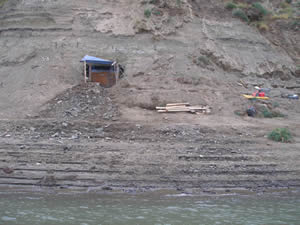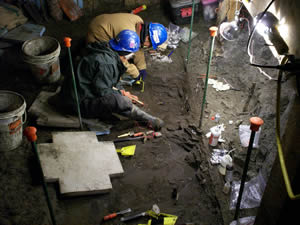New technique breaks ground on North Slope dinosaur research
New technique breaks ground on North Slope dinosaur research
Submitted by Kerynn Fisher
Phone: 907-474-6941
09/27/07


Download photos
Until this year, digging for dinosaurs along the North Slope’s Colville River meant working on a narrow beach, with steep bluffs on one side and the river’s swift, cold waters on the other.
Over the years, University of Alaska Museum of the North staff, students and volunteers collected more than 8,000 teeth and bones from the area, the most productive dinosaur-bearing area in the world’s polar regions. But most of the specimens were shattered into small pieces after being exposed to millennia of freeze-thaw cycles.
Researchers often wondered what they would find if they dug beyond the active layer of the permafrost. Would they find more intact specimens?
This year gave museum staff and collaborators a chance to test this theory and uncover new ground in dinosaur research as they worked in a 6-meter-deep tunnel dug into the side of the bluff.
The project was no small undertaking. In March, museum staff, colleagues from Australia and a mining crew spent three weeks in the frozen North excavating the tunnel. Then, they sealed the tunnel, returned home and waited for the summer field season, returning in August when conditions would be more conducive to field work. When they arrived, they had more work cut out for them: high waters from the spring melt left two feet of ice on the floor of the tunnel.
"We spent the first week just clearing the ice out of the tunnel before we could even begin to excavate the specimens," says museum operations manager and paleontologist Kevin May, one of the principal investigators on the project. "Even after that, the work was slow going."
In three weeks, the museum research team--May, museum earth science curatorial assistant Amanda Hanson, University of Alaska Anchorage geology professor emeritus Anne Pasch, and volunteers Kelly May and Cindy Schraer--excavated approximately 30 centimeters into the frozen ground in two plots, each a meter square. Working outside on the banks, they could have excavated a meter deep in the same amount of time.
The long hours and hard work in the freezing tunnel paid off. The team recovered more than a hundred specimens. Many of the specimens are in excellent condition, including hadrosaur teeth and bones; tyrannosaurid and troodontid teeth; and tiny vertebrae from an as-yet-unidentified dinosaur species, possibly new to Alaska. Outside the tunnel, the team also found a pachyceplalosaur jaw fragment, potentially representing a new species. The dinosaurs date to the late Cretaceous period and are approximately 70 million years old.
"This summer’s work has given us a much better sense of the size and shape of the Liscomb bed," says May, referring to a productive dinosaur bone bed discovered in 1961 by Shell Oil Company geologist Robert Liscomb. "Before this summer, we knew the bed extended along the river bluff for about 100 meters, but we had no idea how far the deposit extended into the bluff. Now, we know that it is at least six meters wide at the tunnel site, and likely even wider. There will be plenty of work there to keep us busy for years to come."
The museum’s work this summer was supported, in part, by a $20,000 contribution from North Slope oil producer ConocoPhillips. The donation helped fund expenses including a boat to transport crew members between the research site and the field camp, lighting for the tunnel and other supplies. ConocoPhillips also provided in-kind support including transporting an air compressor to power jackhammers used to clear the ice from the tunnel, fuel for generators and other logistical support.
In addition to the museum research team, the field crew included researchers from Australia’s Museum Victoria, independent television producer Ruth Berry and cinematographer Paul Warren. Using footage from the spring tunnel excavation, the summer field work and supplemental interviews, Berry is working on a documentary for the public television program NOVA, a production of WGBH-Boston, as well as a documentary for the Australian Broadcasting Company. The productions have the potential to bring international attention to the museum’s North Slope dinosaur research.
CONTACT: Kerynn Fisher, University of Alaska Museum of the North communications coordinator, at 907-474-6941 or 907-378-2559 or Kevin May, University of Alaska Museum of the North operations manager, at 907-474-5358.
Note to editors: Additional images are available on request.


